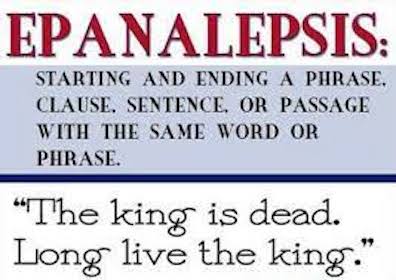Figure of speech. J. J. O'Molloy ends a sentence
with the word that started it: "— Seems to be, J. J.
O'Molloy said, taking out a cigarettecase in murmuring
meditation, but it is not always as it seems." The rhetorical
term for this device is epanalepsis: using the same
word or words at the beginning and the end of a clause,
sentence, or other substantial block of text.
Best pronounced
EH-puh-nuh-LEP-sis, the Greek word means "resumption" (
epi-
= in addition +
ana- = again, anew +
lepsis =
taking, so "taking up again"). In addition to the rhetorical
uses evoked in the illustrations here, there are many powerful
literary examples of the device: "Once more unto the breach,
dear friends, once more" (Shakespeare,
Henry V); "In a
minute there is time / For decisions and revisions which a
minute will reverse" (T. S. Eliot,
The Love Song of J.
Alfred Prufrock); "They went home and told their wives, /
that never once in all their lives, / had they known a girl like
me, / But... They went home" (Maya Angelou,
They Went Home);
"We know nothing of one another, nothing, Smiley mused. However
closely we live together, at whatever time of day or night sound
the deepest thoughts in one another, we know nothing" (John le
Carré,
Call for the Dead); "Next time there won't be a
next time" (
The Sopranos).
J. J. O'Molloy's sentence may seem to repeat only the word
"seems," but in fact his second clause echoes the first one
quite closely, as can be seen by rephrasing the verb structure
of one clause or the other: "It seems that it is, but it is not
always as it seems"; or, "Seems to be, but seeming is not always
being." Since the sentence involves an ABBA structure (seem, be,
be, seem), it could be classed as a instance of
chiasmus.
Other rhetorical terms are very closely related to
epanalepsis: anaphora (beginning successive
sentences, clauses, or lines with the same word or words),
epistrophe (ending successive sentences, clauses or lines with
the same word or words), and symploce (the combination of
anaphora and epistrophe). Symploce is, if not entirely
synonymous, so nearly so that I am not sure what the
difference consists in. As Seidman observes, it too
could be applied to Molloy's sentence.
The term epanalepsis is usually employed in the way described
above: beginning and ending a phrase in the same way. But it
can also be used more loosely to describe any refrain-like
repetition of a word or phrase after intervening words.
Examples of this device, not cited by Gilbert or Seidman, can
be found in John F. Taylor's speech about Moses:
But, ladies and gentlemen, had the youthful Moses
listened to and accepted that view of life, had he bowed
his head and bowed his will and bowed his spirit before
that arrogant admonition he would never have brought the
chosen people out of their house of bondage, nor followed
the pillar of the cloud by day. He would never have
spoken with the Eternal amid lightnings on Sinai's
mountaintop nor ever have come down with the light
of inspiration shining in his countenance and bearing in his
arms the tables of the law, graven in the language of the
outlaw.


